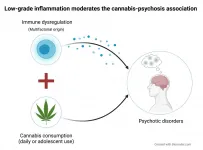(Press-News.org) A new study looking at the way human cells activate the immune system in response to SARS-CoV-2 infection could open the door to even more effective and powerful vaccines against the coronavirus and its rapidly emerging variants keeping the global pandemic smoldering.
Researchers from Boston University's National Emerging Infectious Diseases Laboratories (NEIDL) and the Broad Institute of MIT and Harvard say it's the first real look at exactly what types of "red flags" the human body uses to enlist the help of T cells--killers sent out by the immune system to destroy infected cells. Until now, COVID vaccines have been focused on activating a different type of immune cell, B cells, which are responsible for creating antibodies. Developing vaccines to activate the other arm of the immune system--the T cells--could dramatically increase immunity against coronavirus, and importantly, its variants.
In their findings, published in Cell, the researchers say current vaccines might lack some important bits of viral material capable of triggering a holistic immune response in the human body. Based on the new information, "companies should reevaluate their vaccine designs," says Mohsan Saeed, a NEIDL virologist and the co-corresponding author of the paper.
Saeed, a BU School of Medicine assistant professor of biochemistry, performed experiments on human cells infected with coronavirus. He isolated and identified those missing pieces of SARS-CoV-2 proteins inside one of the NEIDL's Biosafety Level 3 (BSL-3) labs. "This was a big undertaking because many research techniques are difficult to adapt for high containment levels [such as BSL-3]," Saeed says. "The overall coronavirus research pipeline we've created at the NEIDL, and the support of our entire NEIDL team, has helped us along the way."
Saeed got involved after he was contacted by genetic sequencing experts at the Broad Institute, computational geneticists Pardis Sabeti and Shira Weingarten-Gabbay. They hoped to identify fragments of SARS-CoV-2 that activate the immune system's T cells.
"The emergence of viral variants, an active area of research in my lab, is a major concern for vaccine development," says Sabeti, a leader in the Broad Institute's Infectious Disease and Microbiome Program. She is also a Harvard University professor of systems biology, organismic and evolutionary biology, and immunology and infectious disease, as well as a Howard Hughes Medical Institute investigator.
"We swung into full action right away because my laboratory had [already] generated human cell lines that could be readily infected with SARS-CoV-2," Saeed says. The group's efforts were spearheaded by two members of the Saeed lab: Da-Yuan Chen, a postdoctoral associate, and Hasahn Conway, a lab technician.
From the outset of COVID pandemic in early 2020, scientists around the world knew the identity of 29 proteins produced by SARS-CoV-2 virus in infected cells--viral fragments that now make up the spike protein in some coronavirus vaccines, such as the Moderna, Pfizer-BioNTech, and Johnson & Johnson vaccines. Later, scientists discovered another 23 proteins hidden inside the virus' genetic sequence; however, the function of these additional proteins was a mystery until now. The new findings of Saeed and his collaborators reveal--unexpectedly and critically--that 25 percent of the viral protein fragments that trigger the human immune system to attack a virus come from these hidden viral proteins.
How exactly does the immune system detect these fragments? Human cells contain molecular "scissors"--called proteases--that, when the cells are invaded, hack off bits of viral proteins produced during infection. Those bits, containing internal proteins exposed by the chopping-up process--like the way the core of an apple is exposed when the fruit is segmented--are then transported to the cell membrane and pushed through special doorways. There, they stick outside the cell acting almost like a hitchhiker, waving down the help of passing T cells. Once T cells notice these viral flags poking through infected cells, they launch an attack and try to eliminate those cells from the body. And this T cell response isn't insignificant--Saeed says there are links between the strength of this response and whether or not people infected with coronavirus go on to develop serious disease.
"It's quite remarkable that such a strong immune signature of the virus is coming from regions [of the virus' genetic sequence] that we were blind to," says Weingarten-Gabby, the paper's lead author and postdoctoral fellow in the Sabeti lab. "This is a striking reminder that curiosity-driven research stands at the basis of discoveries that can transform the development of vaccines and therapies."
"Our discovery ... can assist in the development of new vaccines that will mimic more accurately the response of our immune system to the virus," Sabeti says.
T cells not only destroy infected cells but also memorize the virus' flags so that they can launch an attack, stronger and faster, the next time the same or a different variant of the virus appears. That's a crucial advantage, because Saeed and his collaborators say the coronavirus appears to delay the cell's ability to call in immune help.
"This virus wants to go undetected by the immune system for as long as possible," Saeed says. "Once it's noticed by the immune system, it's going to be eliminated, and it doesn't want that."
Based on their findings, Saeed says, a new vaccine recipe, incorporating some of the newly discovered internal proteins making up the SARS-CoV-2 virus, would be effective in stimulating an immune response capable of tackling a wide swath of newly emerging coronavirus variants. And given the speed with which these variants continue to appear around the world, a vaccine that can provide protection against all of them would be a game changer.
INFORMATION:
This research was supported by the National Institute of Health, the National Institute of Allergy and Infectious Diseases, the National Cancer Institute (NCI) Clinical Proteomic Tumor Analysis Consortium, a Human Frontier Science Program Fellowship, a Gruss-Lipper Postdoctoral Fellowship, a Zuckerman STEM Leadership Program Fellowship, a Rothschild Postdoctoral Fellowship, the Cancer Research Institute/Hearst foundation, a National Science Foundation Graduate Research Fellowship, EMBO Long- Term Fellowships, a Cancer Research Institute/Bristol-Myers Squibb Fellowship, the Parker Institute for Cancer Immunotherapy, the Emerson Collective, the G. Harold and Leila Y. Mathers Charitable Foundation, the Bawd Foundation, Boston University startup funds, the Mark and Lisa Schwartz Foundation, the Massachusetts Consortium for Pathogen Readiness, the Ragon Institute of MGH, MIT and Harvard, and the Frederick National Laboratory for Cancer Research.
Steroid (sex) hormones play a central role in sexual development: They help determine how boys become boys and girls become girls. If these hormones are disrupted during fetal life, it can lead to a string of reproductive disorders at birth and later in life, including malformed genitals and decreased fertility.
Many environmental chemicals are known to disrupt the hormone system and are often referred to as endocrine disrupting chemicals. Azole fungicides constitute one group that can act as endocrine disruptors. Azoles are used to combat yeast infestations in seed and food crops, but are also used in medications for humans.
Most azoles used in medicines are tightly regulated and their use is well controlled. However, some are sold over-the-counter, for ...
Philadelphia, June 16, 2021 - The SARS-CoV-2 virus that causes COVID-19 may have the ability to reactivate dormant tuberculosis (TB). In a novel study scientists END ...
In a new publication from Cardiovascular Innovations and Applications; DOI https://doi.org/10.15212/CVIA.2021.0011, Xiao-lei Yin, Dong-xue Liang, Lu Wang, Jing Qiu, Zhi-yun Yang, Jian-zeng Dong and Zhao-yuan Ma from Tsinghua University, Beijing, China; Capital Medical University, Beijing, China and The First Affiliated Hospital of Zhengzhou University, Zhengzhou, China analyse coronary angiography video interpolation methods to reduce x-ray exposure frequency based on deep learning.
Cardiac coronary angiography is a major technique that assists physicians during interventional heart surgery. Under X-ray irradiation, the physician ...
In a new publication from Cardiovascular Innovations and Applications; DOI https://doi.org/10.15212/CVIA.2021.0013, Sharen Lee, Gary Tse, Xin Wang, Adrian Baranchuk and Tong Liu from Laboratory of Cardiovascular Physiology, Hong Kong, China, Second Hospital of Tianjin Medical University, Tianjin, China and Queen's University, Kingston, Ontario, Canada consider ST-segment depression in leads I and aVL.
The 12-lead electrocardiogram (ECG) is a routinely performed test but is susceptible to misinterpretation even by experienced physicians. The authors report a case of a 72-year-old lady with no prior cardiac history presenting with atypical chest pain. Her initial electrocardiogram shows an initial ST depression followed by positive deflections leads I and aVL. ...
Commonplace pharmaceuticals, such as ibuprofen, can carry with them an inherent flaw in their atomic structure, which pairs the active, beneficial ingredient with a potentially ineffective -- or even toxic -- counterpart. New research could hold the key to more easily isolating the good while removing the unwanted.
Dr. Shoufeng Lan, assistant professor in the J. Mike Walker '66 Department of Mechanical Engineering at Texas A&M University, is leading a team investigating the use of electromagnetic control over the synthesis of chiral compounds at an atomic level -- a process that could lead to a plethora of practical ...
How do top athletes talk about doping when they themselves are using performance-enhancing drugs? Or do they just avoid the issue? A new study by the University of Göttingen reveals that any decision to use drugs almost inevitably means the decision to engage in deceptive communication such as lying or omitting information. Those using drugs, for example, regularly describe anti-doping policies as being more intense than ever or overly restrictive, play down the extent of the doping problem, or portray themselves as victims. The results were published in the European Journal for Sport and Society.
Dr Marcel Reinold, Head of Sport and Health Sociology at the Institute of Sport and Exercise Sciences at Göttingen University, analysed autobiographies of professional ...
A new paper in the journal Cognition examines the visual complexity of written language and how that complexity has evolved.
Using computational techniques to analyze more than 47,000 different characters from 133 living and extinct scripts, co-authors Helena Miton of the Santa Fe Institute and Oliver Morin of the Max Planck Institute for the Science of Human History, addressed several questions around why and how the characters of different writing systems vary in how complex they appear.
"When we started this project, we wanted to test whether you find a general simplification of characters over time," Miton says. "Do scripts simplify their ...
The presence of pro-inflammatory cytokines in the blood can boost the effects of daily cannabis use and heighten the risk of developing psychosis in adulthood. Similar results have been observed, also in the presence of cytokines, when cannabis is used during adolescence. Psychotic disorders have symptoms such as delirium, loss of a sense of reality, hallucinations, hearing voices, and cognitive and social impairments.
A study by researchers at the University of São Paulo's Ribeirão Preto Medical School (FMRP-USP) in Brazil, reported in an article in ...
RUDN University biologist studied the aggressive impact of environmental factors (water, salts, and ozone) on ultrathin nanofibers of biopolymers. The results will help choosing suitable bioplastic depending on the use; for example, for medical implants, biodegradable packaging or filters for water cleaning. The results are published in the journal Polymers.
Bioplastics are an alternative to ordinary plastics. They are obtained from waste of plant and food industry. The safe composition allows using them as filters for gases and liquids, as "sponges" for cleaning reservoirs and medical implants. Depending on the field ...
NEW YORK, NY (June 16, 2021)--Spectacular images of a molecule that shuttles omega-3 fatty acids into the brain may open a doorway for delivering neurological therapeutics to the brain.
"We've managed to obtain a three-dimensional structure of the transporter protein that provides a gateway for omega-3s to enter the brain. In this structure, we can see how omega-3s bind to the transporter. This information may allow for the design of drugs that mimic omega-3s to hijack this system and get into the brain," says first author Rosemary J. Cater, PhD, a Simons Society Fellow in the Mancia Lab at Columbia University Vagelos College of Physicians and Surgeons.
The study was published online on June 16 in the journal Nature.
A major challenge in treating ...




